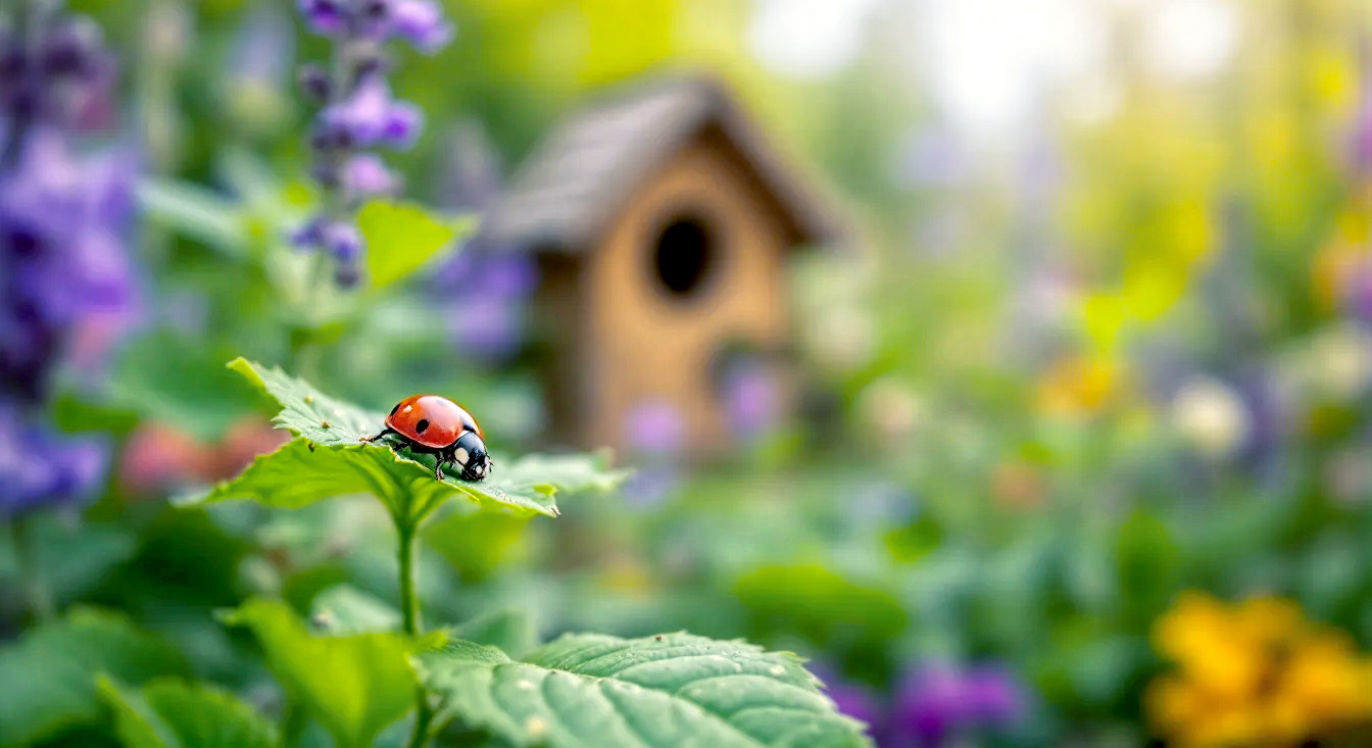The Great British Garden Watch: A Year-Round Guide to Pests and Protectors
Discover the friends and foes in your garden. Our year-round guide helps you manage pests naturally and create a thriving wildlife haven in the UK.

This post may contain affiliate links. If you make a purchase through these links, we may earn a commission at no additional cost to you.
Gardening in Britain is a national pastime, a glorious, muddy, and often frustrating affair. One minute you’re admiring a perfect rose, the next you’re wondering what’s turned your prize-winning hostas into something that resembles green lace. It can feel like a constant battle, a turf war fought with trowels and pellets against an invisible, munching army.
But what if we looked at it differently? Your garden isn’t a battlefield; it’s a bustling, vibrant community. It’s an ecosystem teeming with life, full of heroes and villains, helpers and hindrances. Learning to tell them apart is the secret to a truly thriving patch of earth. It’s about knowing your friends from your foes.
This guide is your year-round intelligence briefing. We’ll walk through the seasons, identifying the main troublemakers that threaten your plants and celebrating the unsung heroes—the protectors—that work tirelessly on your behalf. Forget harsh chemicals and endless warfare. It’s time to become a garden diplomat, gently tipping the balance of power in your favour to create a garden that’s not just beautiful, but bursting with life.
The Big Idea: It’s All About Balance
Before we dive into the seasonal specifics, let’s get our heads around the core concept: your garden is a miniature world. In this world, everything wants to eat something, and everything can be eaten by something else. The so-called ‘pests’ are just creatures trying to have their dinner. The problem only starts when their numbers get out of control because there’s nothing around to eat them.
This is where your garden protectors come in. These are the beneficial bugs, birds, and other beasties that prey on the pests. Think of ladybirds as tiny, spotty tanks, munching their way through aphid armies, or a song thrush as your personal slug security guard.
The goal isn’t to wipe out every single pest. That’s impossible and, frankly, a bit mean. The aim is to create a balanced ecosystem where the protectors keep the pests in check. This approach is often called Integrated Pest Management (IPM). It sounds technical, but it’s simple: work with nature first. Encourage the good guys, put up some simple defences, and only reach for a spray (preferably an organic one) as a last resort. A garden with a bit of everything—predators, prey, and a wide variety of plants—is a healthy, resilient garden.
Spring (March, April, May): The Great Awakening
As the soil warms up and the first brave daffodils poke their heads out, your garden’s inhabitants are also stirring from their winter slumber. Everyone is hungry, and your tender new shoots look like a delicious breakfast buffet.
Spring Foes: The Usual Suspects
Your main mission in spring is to protect young, vulnerable plants from the first wave of attack.
Slugs and Snails
The arch-nemesis of every British gardener. As soon as the damp, mild weather arrives, they glide out from their hiding places, ready to decimate seedlings and hostas overnight. You’ll know they’ve visited by the chewed, ragged holes in leaves and their tell-tale slimy trails.
- How to Deal with Them: Forget the bright blue pellets, which can harm birds and hedgehogs. Instead, try a multi-pronged, eco-friendly attack.
- Beer Traps: A classic for a reason. Sink a jam jar or yogurt pot into the soil so the rim is at ground level and half-fill it with cheap beer or a yeasty, sugary water mix. Slugs are drawn to the scent, fall in, and drown.
- Copper Tape: Slugs and snails hate crawling over copper as it gives them a tiny electric shock. Stick self-adhesive copper tape around the rims of your pots and containers to create a barrier they won’t cross.
- Rough Surfaces: They also dislike crawling over sharp stuff. Surround precious plants with a circle of crushed eggshells, sharp grit, or wool pellets.
- Go on a Night Patrol: The most effective method is often the simplest. Head out after dark with a torch and a bucket. Pick them off your plants by hand and relocate them somewhere far away (or dispose of them as you see fit).
Aphids (Greenfly and Blackfly)
These tiny, sap-sucking insects appear as if from nowhere, clustering on the juicy new growth of roses, broad beans, and lupins. A small group isn’t a disaster, but they multiply incredibly fast. They weaken the plant, distort its growth, and secrete a sticky substance called ‘honeydew’, which can lead to sooty mould.
- How to Deal with Them:
- A Good Squirt: For a small infestation, a strong jet of water from a spray bottle or hose is often enough to blast them off.
- Soapy Water: Add a few drops of washing-up liquid to a spray bottle filled with water. This breaks down the aphids’ protective outer layer. Just be sure to test it on a small area first, as some plants can be sensitive.
- Finger and Thumb: The simple squish method is surprisingly effective, if a little grim.
Vine Weevil Grubs
These are sneaky, destructive pests. The adult weevils are dull black beetles that chew notches out of leaves at night, but the real damage is done by their larvae. These are creamy-white, C-shaped grubs that live in the soil of pots and containers, eating plant roots. If a potted plant suddenly wilts and dies for no reason, tip it out and check for these grubs. They absolutely love heucheras, strawberries, and primroses.
- How to Deal with Them:
- Nematode Power: The best organic control is to water a biological control called pathogenic nematodes into the soil in spring or late summer. These are microscopic worms that hunt down and kill the weevil grubs but are harmless to everything else. You buy them online and they arrive in a packet to be mixed with water.
- Check New Plants: Always check the rootball of any new plants you buy, especially from garden centres, before planting them.
Spring Friends: The Cavalry Arrives
Just as the pests are waking up, so are their predators. Your job is to make them feel welcome.
Ladybirds
Everyone loves a ladybird. Both the adults and their slightly terrifying, spiky black-and-orange larvae are aphid-eating machines. A single ladybird can eat up to 5,000 aphids in its lifetime. Don’t mistake the larvae for pests!
- How to Attract Them: They hibernate in sheltered spots, so leaving a pile of logs or a bug hotel over winter helps. They are also attracted to pollen-rich flowers.
Frogs, Toads, and Newts
If you’re lucky enough to have a pond, you have the ultimate slug and snail patrol. These amphibians emerge from hibernation in spring, hungry for a slimy meal.
- How to Attract Them: A pond is the number one attraction. It doesn’t need to be huge; even a sunken bucket or old sink with a ramp for access will do. Provide some rocks or a log pile nearby for shelter.
Bees and Hoverflies
While not strictly ‘pest controllers’, these are vital protectors of your garden’s health. Bees are your master pollinators, ensuring you get fruit, veg, and seeds. Hoverflies are brilliant too; their larvae look like tiny green maggots and have a massive appetite for aphids.
- How to Attract Them: Plant a succession of single-petaled, open flowers from spring to autumn. Things like crocuses, apple blossom, lavender, and cosmos are perfect. Avoid “double” flowers with dense petals, as insects can’t access the pollen and nectar.
Summer (June, July, August): The Garden in Full Swing
Summer is when the garden hits its peak—and so does the pest activity. Everything is growing fast, including the populations of things that want to eat your plants.
Summer Foes: The Heat is On
Warm, dry weather brings its own set of problems, while lush growth provides a feast for others.
Cabbage White Butterflies
Those pretty white butterflies fluttering over your vegetable patch are not as innocent as they look. They are laying eggs on the underside of the leaves of your cabbages, kale, broccoli, and Brussels sprouts. These hatch into voraciously hungry caterpillars that can strip a plant to a skeleton in days.
- How to Deal with Them:
- Netting is Key: The most effective defence is physical. Cover your brassica plants with fine insect-proof mesh or netting as soon as you plant them out. Make sure it’s secure at the edges so the butterflies can’t sneak underneath.
- Check for Eggs: Regularly check the underside of leaves for little clusters of yellow, skittle-shaped eggs and wipe them off.
- Companion Planting: Some gardeners swear by planting strong-smelling companions like mint or nasturtiums nearby to confuse the butterflies. Nasturtiums can also act as a ‘sacrificial crop’—the butterflies might lay their eggs there instead of on your cabbages.
Blackfly and Greenfly (Aphids Again!)
Aphids love the hot weather. You’ll find blackfly smothering the tips of your broad beans and greenfly all over your roses. Their populations can explode in summer.
- How to Deal with Them: All the spring methods still apply. In summer, you can also rely on the booming populations of their natural predators. If you see ladybirds or hoverfly larvae on an infested plant, try to hold off spraying so you don’t harm the helpers.
Red Spider Mites
These tiny pests are a nightmare in greenhouses and on houseplants, thriving in hot, dry conditions. They are almost invisible to the naked eye, but you’ll spot their effects: a fine, silky webbing over the leaves and a mottled, dusty appearance on the plant. They suck the sap, causing leaves to turn yellow and drop off.
- How to Deal with Them:
- Boost Humidity: Mites hate damp conditions. Regularly mist your plants with water to raise the humidity.
- Biological Control: For a serious greenhouse infestation, you can buy and release a predatory mite called Phytoseiulus persimilis. This tiny predator hunts and eats red spider mites and is a fantastic example of letting the good guys do the work.
Powdery Mildew
Not a bug, but a common fungal foe in summer. It looks like a white, dusty coating on the leaves of plants like courgettes, roses, and phlox, especially during spells of dry weather followed by humid evenings. It stresses the plant and can reduce your harvest.
- How to Deal with It:
- Watering: Water plants at the base, not over the leaves, and water regularly so the soil doesn’t completely dry out.
- Airflow: Don’t plant things too close together. Good air circulation helps prevent fungal spores from settling.
- Remove Affected Leaves: Snip off and dispose of (don’t compost) the worst-affected leaves to stop it from spreading.
Summer Friends: The Professionals Move In
By summer, the garden’s security team is at full strength.
Spiders
Often unloved, spiders are incredible pest controllers. The webs of garden spiders catch huge numbers of flies and other airborne pests, while hunting spiders like wolf spiders patrol the ground for insects. Don’t destroy their webs.
- How to Attract Them: They love structure. Mulches, low-growing plants, and dense shrubs give them places to hunt and build their webs.
Ground Beetles
These are the night shift. Large, shiny black beetles that scuttle away when you lift a stone. They are brilliant predators, munching on slug eggs, caterpillars, and other soil-dwelling pests.
- How to Attract Them: A log pile, a patch of long grass, or some stones provide the perfect daytime hiding spots for these nocturnal hunters.
Hedgehogs
Our beloved prickly friends are in their prime in summer. A single hedgehog can eat dozens of slugs, snails, and caterpillars in one night. They are a gardener’s absolute best friend.
- How to Attract Them: The most important thing is access. Create a 13cm x 13cm (5×5 inch) hole in your fence or wall—a ‘Hedgehog Highway’—to let them roam between gardens. Leave a shallow dish of water and some meaty cat or dog food (not bread or milk!). A log pile or a wild corner will give them somewhere to rest.
Autumn (September, October, November): The Harvest and Tidy-Up
The pace in the garden starts to slow, but there are still jobs to do and pests to watch out for. Autumn is your chance to disrupt pest life cycles before winter sets in.
Autumn Foes: The Late Shift
Some pests are at their most destructive now, while others are trying to find a place to hide for the winter.
Codling Moth
If you’ve ever bitten into a home-grown apple and found a little maggot near the core, you’ve met the larva of the codling moth. The moths lay their eggs in early summer, and the caterpillars burrow into the developing fruit.
- How to Deal with Them:
- Grease Bands: In autumn, wrap grease bands or fruit tree grease around the trunks of your apple and pear trees. This stops the female moths (which are wingless) from crawling up the tree to lay their eggs next year.
- Pheromone Traps: In early summer, hang pheromone traps in the trees. These lure and catch the male moths, reducing mating and giving you an early warning that they’re active.
- Clear Up Windfalls: Don’t let fallen, infested fruit rot on the ground. The caterpillars will crawl out and complete their life cycle in the soil. Clear them up and dispose of them.
Chafer Grubs and Leatherjackets
Have you noticed patches of your lawn turning yellow and dying, and birds (especially magpies and starlings) pecking at it furiously? The likely culprits are chafer grubs (fat, white grubs similar to vine weevils) or leatherjackets (grey-brown, legless grubs, the larvae of crane flies or daddy-long-legs). They live in the soil and eat the grass roots.
- How to Deal with Them:
- Nematodes Again: Just like for vine weevils, specific types of pathogenic nematodes are the best chemical-free control. You apply them to the lawn with a watering can in late summer or early autumn when the soil is warm and moist.
Squirrels
Cute but infuriating. Autumn is when squirrels start burying their winter food stores, and they seem to think the pot where you’ve just planted your prize tulip bulbs is the perfect spot. They will happily dig up and either eat or re-bury your bulbs.
- How to Deal with Them:
- Get Poky: After planting bulbs in pots or borders, lay some chicken wire or a prickly shrub cutting (like holly or rose clippings) over the surface of the soil. The squirrels won’t want to dig through it. Remove it in spring when the shoots appear.
Autumn Friends: The Clean-Up Crew
Some of your garden helpers are still hard at work, while others are looking for a safe place to spend the winter.
Birds
As insects become scarcer, birds will be grateful for any pests they can find. Blue tits will search tree bark for overwintering insects, and robins will follow you around as you dig, hoping you’ll unearth a tasty grub.
- How to Help Them: Put up bird feeders and provide fresh water to encourage them to see your garden as a reliable food source. They’ll repay you by eating pests all year round.
Centipedes
Often mistaken for pests, these fast-moving, many-legged creatures are ferocious predators. You’ll find them under pots and in the compost heap. They hunt slugs, worms and other small soil creatures. They have a venomous bite for their prey, so while they’re great for the garden, it’s best not to handle them.
Hibernating Helpers
Ladybirds will be looking for crevices to hibernate in, often in sheds, window frames, or dedicated bug hotels. Queen bumblebees will be searching for a dry, sheltered spot, perhaps in an old mouse hole or under a pile of leaves. Be careful not to disturb them. A slightly messy garden is a wildlife-friendly garden.
Winter (December, January, February): The Quiet Season
The garden may look dormant, but life hasn’t stopped. This is a time for planning, protecting, and supporting the wildlife that stays the course through the cold British winter.
Winter Foes: The Die-Hards
Pest activity is at a minimum, but a few hardy characters can still cause problems.
Mice and Voles
These small mammals might seek shelter in your shed or greenhouse, where they can nibble on stored seeds, bulbs, and winter salads.
- How to Deal with Them: Store seeds and bulbs in secure metal or hard plastic containers. Use humane traps if you need to, but check them regularly. A cat can be a very effective, if ruthless, deterrent.
Pigeons
The ultimate opportunist. In a cold snap when other food is scarce, a flock of pigeons can strip the leaves from your winter brassicas (kale, sprouts, cabbages) in an afternoon.
- How to Deal with Them: Netting is the only reliable solution. Make sure it’s taut and well-pegged down so birds can’t get trapped in it.
Fungal Diseases
In damp, mild winters, diseases like grey mould (Botrytis) and other rots can take hold, especially in greenhouses.
- How to Deal with Them: Good hygiene is crucial. Clear away any dead or dying leaves and debris promptly. Ensure there’s good ventilation in your greenhouse—open the doors and vents for a while on dry, sunny days.
Winter Friends: The Survivors
Your main role in winter is to provide for the friends who stick around.
Garden Birds
Winter is tough for birds. Providing high-energy food like fat balls, sunflower hearts, and mealworms can be a lifesaver. A reliable food source means they will stay in your area, ready to snap up aphids and caterpillars in the spring. Remember to provide fresh, unfrozen water too.
Hibernating Wildlife
Your hedgehog is hopefully snoozing in a log pile, and ladybirds are tucked away in a bug hotel. The most important thing you can do for them is not to disturb them. Avoid having a massive, disruptive tidy-up on a mild winter’s day. That compost heap or pile of leaves could be someone’s home.
Your Year-Round Action Plan: Building a Resilient Garden
Managing pests and protectors isn’t just about seasonal reactions; it’s about creating a permanent haven for the good guys.
1. Plant for a Balanced Diet
Plant a wide variety of plants, especially those that provide nectar and pollen for insects. This is like opening a 24/7 café for beneficial bugs.
- Top Picks: Lavender, marigolds, borage, buddleia, verbena bonariensis, cosmos, and ivy (especially its autumn flowers). Don’t forget to include UK native plants where you can.
2. Provide Water
A source of water is vital for all wildlife.
- What to do: A grand pond is fantastic, but a simple bird bath or even a shallow dish filled with pebbles and water will provide a drink for birds, bees, and hedgehogs.
3. Build Homes for Wildlife
Give your protectors somewhere to live and raise their young.
- What to do:
- A Log Pile: Simple but brilliant for beetles, centipedes, frogs, and hedgehogs.
- A Bug Hotel: A fun project that provides nesting sites for solitary bees and shelter for ladybirds and lacewings.
- A Compost Heap: A warm, living world of its own, full of helpful creatures.
- Leave a Little Wild: Don’t be too tidy. A small patch of long grass or a corner with some nettles can be an invaluable habitat for insects.
4. Ditch the Chemicals
Every time you spray a chemical pesticide, you risk harming the beneficial insects as well as the pests. This can upset the natural balance and lead to you being even more reliant on sprays in the future. Always try physical or biological controls first.
A Final Word
Viewing your garden through the lens of friends and foes changes everything. You stop seeing a slug trail as a personal insult and start wondering if you can encourage a thrush to visit. You learn to recognise the strange-looking hoverfly larva on your roses as a tiny bodyguard, not another pest.
Your garden is a dynamic, living story that unfolds throughout the year. By understanding the characters and their roles, you become less of a weary warrior and more of a wise director, gently guiding the narrative towards a happy, healthy, and beautifully balanced conclusion. Happy gardening.
Further Reading
For more detailed advice and inspiration, explore these excellent resources:
- Royal Horticultural Society (RHS): https://www.rhs.org.uk/advice/pests-diseases
- The Wildlife Trusts: https://www.wildlifetrusts.org/actions
- Garden Organic: https://www.gardenorganic.org.uk/
- Hedgehog Street: https://www.hedgehogstreet.org/






